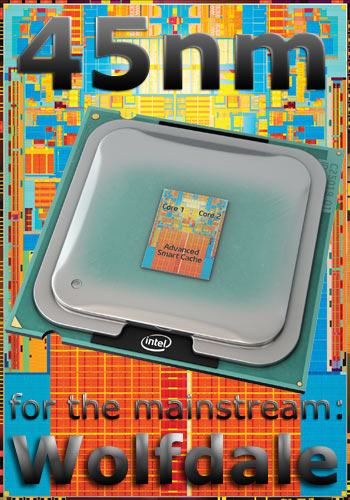Wolfdale Shrinks Transistors, Grows Core 2
The New Core 2 Duo: 45 nm Wolfdale Replaces 65 nm Conroe
Intel's 65 nm generation isn't dead yet, as the firm will still be offering multiple models in the server, desktop and notebook spaces for a while. The processors used in Apple's ultra portable Mac Book Air and Lenovo's upcoming X300 series are good examples. Both devices are based on power-optimized sub 20 Watt versions of the 65 nm Merom core, which means that the first generation of Core 2 will still be around for a while. However, Intel has recently introduced its latest and greatest product generation: the Core 2 Duo E8000 family, based on the 45 nm Wolfdale dual core. The new architecture offers new features, more clock speed and additional cache speed - all the while lowering power consumption. We looked at the new architecture to find out how much of an improvement the new processor generation really offers.
Since Intel started to relax its information policy a few years ago, details about future products have been made available earlier than in the past. Pre-launch data about the new 45 nm Core 2 Duo was no exception. While the top model, the Core 2 Extreme QX9650, Compare Prices on Core 2 Extreme QX9650 which is based on four processing cores, was already launched in late 2007, the dual-core processors for the mainstream have been available for only a few weeks. The key improvements hence didn't come as a surprise. The new 45 nm core, code named Wolfdale, is still based on the second generation Core micro architecture, and it succeeds the 65 nm Conroe core. You may have heard about Penryn as well; this is Intel's code name for the entire 45 nm product family as well as the mobile version. Merom refers to the 65 nm desktop and mobile CPU generation.
The 45 nm Wolfdale processors offer a 6 MB L2 cache size, which is 50% larger than the 65 nm Merom's 4 MB cache. Intel has shrunk the die size from 143 to 107 mm². Cut-down versions with only 3 MB L2 cache are expected to follow shortly. All models are powered by the hafnium-based high-K metal gate silicon manufacturing process, which helps to reduce leakage currents and leads to power management improvements. This has translated into a reduction in both maximum and idle power requirements. As we saw in our review of the 45 nm Core 2 Extreme QX9650, the improvements are welcome features.
So far, Intel has launched three mainstream models: the Core 2 Duo E8200, E8400 and E8500, running at 2.66, 3.0 and 3.16 GHz, and a 333 MHz system clock speed (FSB1333). Since a dual-core Xeon X5272 running at 3.4 GHz (80 W TDP) has already been launched, we're sure that there are clock speed margins that Intel should be able to access almost at any time. Although we'd love to see a high-speed dual-core processor, it will likely not arrive anytime soon, as AMD hasn't been able to compete with Intel in the high end. But you may get the results you want yourself; in fact, we have been successful in overclocking the Core 2 Duo Wolfdale by a significant margin.
We will look at the new processors' technical details and their performance in this first part of our Wolfdale review, and in the second part, we will analyze their overclocking capabilities and the power requirements when they're used for everyday workloads over a defined period of time.
Get Tom's Hardware's best news and in-depth reviews, straight to your inbox.
Current page: The New Core 2 Duo: 45 nm Wolfdale Replaces 65 nm Conroe
Next Page 45 nm Vs. 65 nm
Patrick Schmid was the editor-in-chief for Tom's Hardware from 2005 to 2006. He wrote numerous articles on a wide range of hardware topics, including storage, CPUs, and system builds.
